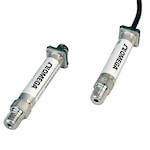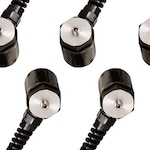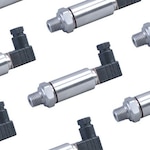A pressure transducer, also commonly called a pressure transmitter or pressure sensor, is an electromechanical device used to measure pressure with high accuracy. It detects the pressure of air, gases, or liquids and converts that measurement into a usable output—typically an electrical signal such as voltage or current—that can be monitored or processed by other systems and devices.
Pressure transducers are widely used across industries to monitor and control the pressure of gases and liquids in systems such as HVAC, automotive, aerospace, medical equipment, and industrial process control, where accurate measurement is essential for safety, efficiency, and reliability.
How Does a Pressure Sensor Work?
A step-by-step breakdown:
- Pressure Applied
- Mechanical Deformation
- Electrical Charge/li>
-
Attached sensing elements—such as strain gauges, piezoelectric crystals, or capacitive plates—detect this deformation and convert it into an electrical change (resistance, charge, or capacitance)
- Signal Conversion
- System Output
-
A gas or liquid exerts force against the sensor's diaphragm (a thin, flexible membrane)
-
The diaphragm bends or deflects in proportion to the amount of pressure applied
-
The sensor’s internal electronics process this small change and convert it into a standardized electrical output, usually a voltage, current (4–20 mA), or digital signal.
-
The resulting signal is sent to a display, controller, or data acquisition system, where it can be monitored, recorded, or used for automatic control.
Pressure Transducer Types
Pressure transducers are not one-size-fits-all devices—different designs are optimized for specific applications, environments, and measurement ranges. While all pressure transducers share the same basic purpose of converting pressure into an electrical signal, the way they achieve this can vary significantly.
Understanding the major types of pressure transducers is essential when selecting the right device for your application, whether it involves monitoring subtle atmospheric changes, measuring high-pressure hydraulic systems, or ensuring safe operation in harsh industrial environments.
Strain-Gauge (Piezoresistive)
These use a diaphragm with bonded strain gauges arranged in a Wheatstone bridge. As pressure flexes the diaphragm, resistance shifts and the bridge produces a proportional signal. They’re rugged, accurate for static measurements, and common across industrial, automotive, and hydraulic systems.
Capacitive
A flexible diaphragm forms one plate of a capacitor; pressure moves the diaphragm and changes capacitance. Because tiny deflections are easy to detect, capacitive designs excel at low and very low pressures and in differential measurements. They’re popular in HVAC, environmental monitoring, and other applications where sensitivity is paramount.
Piezoelectric
Crystals such as quartz generate charge when stressed. That makes piezoelectric sensors fantastic for fast, dynamic events—combustion cycles, shock, pulsation—where high bandwidth matters. They’re not suited to true static pressure because the charge bleeds off over time.
Resonant (Quartz or Silicon Resonant)
For these types of sensors, pressure alters the resonant frequency of a vibrating element, and the sensor measures that frequency shift. The result is exceptional long-term stability and precision with very low drift, which is why resonant sensors show up in calibration references and other high-accuracy roles. Packaging and thermal control are key to their performance.
Optical (Fiber-Optic / FBG)
Optical designs use light to sense diaphragm or fiber strain, so the sensing point is electrically passive and immune to EMI. That makes them a natural fit near MRI equipment, high-voltage gear, in explosive atmospheres, or in miniature medical probes. They do require an optical interrogator and careful installation to realize their advantages.
Potentiometric
A mechanical linkage moves a wiper across a resistive track as the diaphragm deflects, producing a simple position-to-voltage output. The approach is inexpensive and straightforward, but moving contacts introduce wear and limit long-term accuracy. As a result, you’ll see potentiometric transducers more in legacy or low-demand applications than in new designs.
Types of Pressure Signal Outputs
When a pressure transducer is powered and exposed to pressure, it produces an electrical signal proportional to that pressure. The most common output formats are millivolt (mV/V), voltage, current (4–20 mA), and digital. The right choice depends on cable length, electrical noise, available power, and the host system’s interface.
Millivolt (Ratiometric) Outputs
The bridge output (in mV) scales with the excitation voltage (mV/V). Because the signal is small, a regulated supply, short cable runs, and low-noise environments are recommended. With minimal electronics, these sensors are compact, rugged, and handle harsh conditions well.Best for: Short distances, low noise environments, and applications prioritizing robustness and small size.
Voltage Outputs
Typical ranges are 0–5 V, 0–10 V, or 1–5 V. Internal signal conditioning produces a higher-level output that’s less sensitive to supply variation and electrical noise than mV signals. Cable lengths are moderate; good shielding and grounding improve performance.
Best for: Industrial settings with some electrical noise where a simple, high-level analog input is available.
Current loop output (typically 4–20 mA)
A two-wire, loop-powered transmitter modulates current rather than voltage, making the signal highly resistant to electrical interference and voltage drop over long cables. It’s the de-facto standard in process industries. (0–20 mA exists but 4–20 mA is most common.)
Best for: Electrically noisy environments and long cable runs (hundreds of meters/over 1000 ft), especially in process control.
Digital Outputs (Smart Transducers)
Digital transducers communicate via protocols such as Modbus/RS-485, CAN, HART, I²C, or SPI. Beyond pressure, they can report metadata (e.g., calibration, serial/asset info), log data, trigger alarms, and support remote configuration. Transmission distance and topology depend on the protocol and cabling—often suitable for long runs.
Best for: Long distances, advanced diagnostics, multi-parameter data, and integration with modern controls/SCADA.


